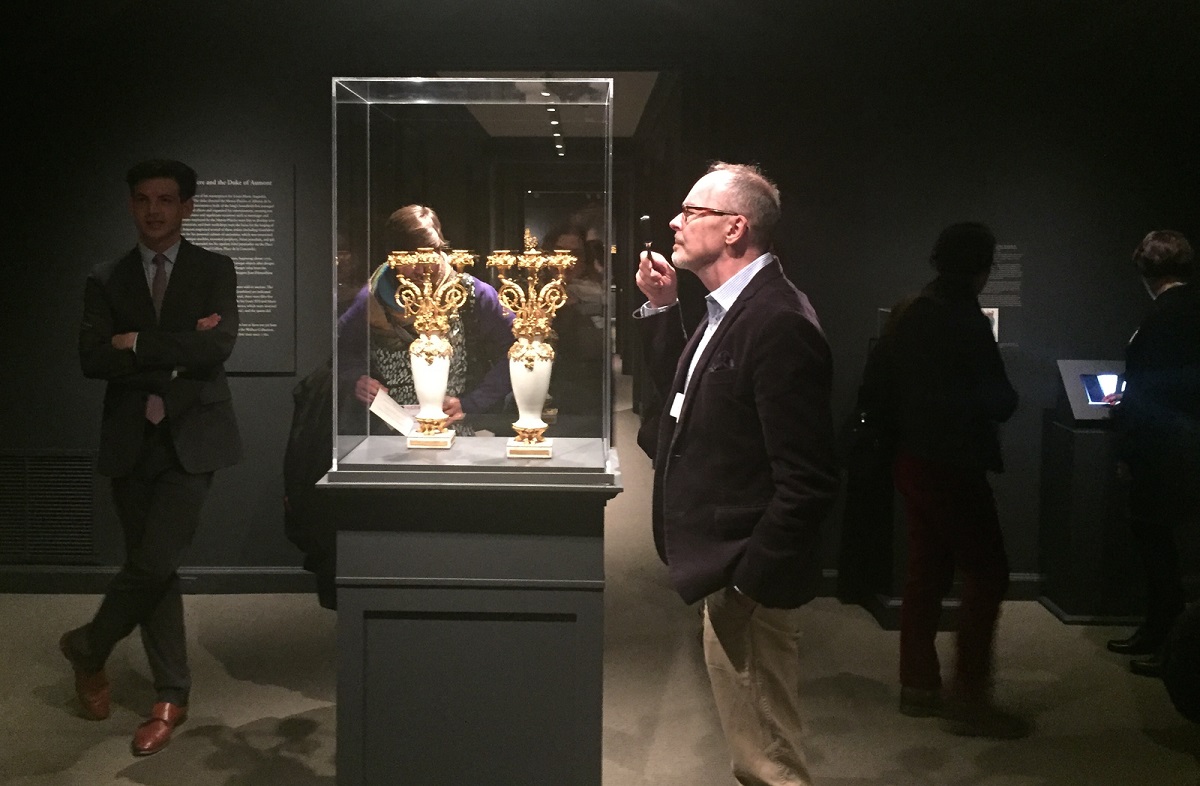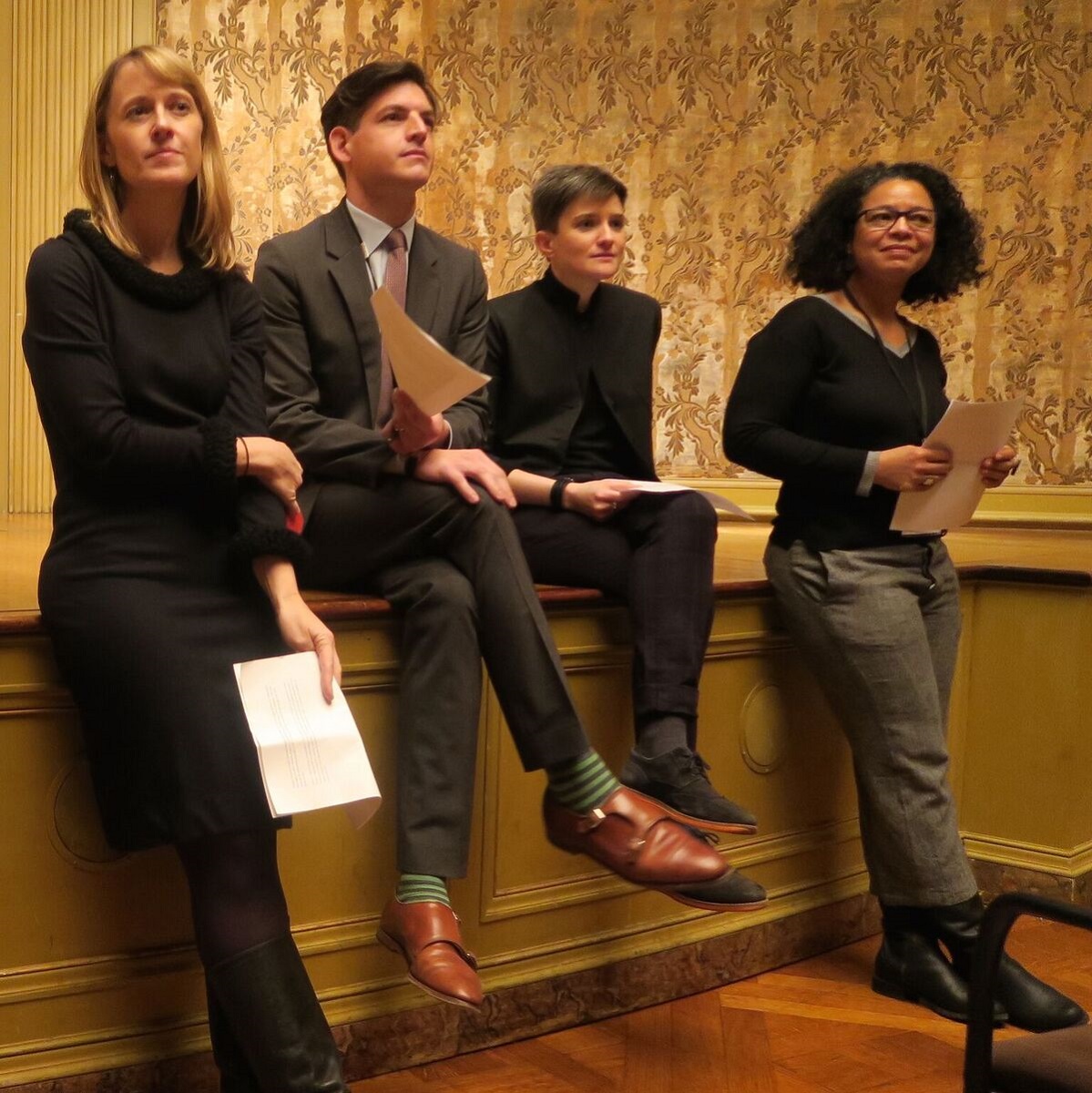It’s an interesting moment to be a scholar of eighteenth-century art. A neglected field in English-language art history for most of the twentieth century, it is currently enjoying a boom. One can no longer rightly say that it is an understudied subject, the purview of a tiny community of specialists. The roundtable discussion – Perspectives on 18th-Century Art History – sponsored by Journal18 and The Frick Collection, held at the Frick on 17 February 2017, offered an opportunity to ponder where the study of eighteenth-century art currently stands, how its priorities might be defined, and where it might go in the future.

Curator’s tour of the Frick’s Gouthière exhibition. Photo: Noémie Étienne.
The event was an informal discussion in which speakers offered brief statements about broad themes followed by a discussion. Preceding it was a private tour, led by curator Charlotte Vignon, of the Frick’s wonderful exhibition of decorative arts by the French gilder Pierre Gouthière. Meredith Martin, New York University, moderated the event. The first topic was The Digital, presented by Carrie Anderson, Middlebury College, and Nancy Um, Binghamton University. They mentioned both the positive and negative sides of digital scholarship, emphasizing the increased access and data visualization that digital technologies enable. Um offered some interesting remarks regarding the challenge of making digital projects last in an era of swift technological change, and whether that should even be a priority, as well as on how digital platforms could be misused. The microphone then went to Hannah Williams, Queen Mary University London, who spoke on The Biographical. Biography is a dirty word in some corners of art history, evoking as it does the unified authorial subject that much poststructuralist thought has sought to dismantle. Williams made a case for rethinking biography as a vital interpretive structure for art-historical writing, one that positions the artist as a frame and focus for art’s meanings. She advocated pursuing this not by ascribing simplistic psychological motivations to artists, but by locating their experiences more precisely in specific material settings.
The discussion then turned to The Global, with comments by Anne Lafont of INHA, Paris. Lafont began by questioning the validity of a world art history based in a universal conception of art. Rather, she structured her comments around the dual concepts of connection and creolization. She argued provocatively that much eighteenth-century art is less the product of hybridization, as is often said, but rather of creolization, the forced contact between cultures through trade, commerce, and slavery. Noémie Etienne, University of Bern, then turned attention to The Material. She noted the increasing use of “material” and “materiality” in art-historical writing. She then proposed conservation studies as a way of analyzing materiality and urged that materiality could be a source of new knowledge about art. The final presenter was David Pullins, MIT, who spoke on The Decorative. He proposed the social history of art as the basis of the recent renaissance of interest in the decorative arts, which he approached in two ways. The first understood decoration as non-figural art prior to the advent of twentieth-century abstraction, a key concept in eighteenth-century art. The second was the way in which a global scope might decentralize paintings and force scholars to confront the decorative status of much material in their field.

Roundtable participants: Meredith Martin, David Pullins, Hannah Williams, and Anne Lafont. Photo: Valérie Kobi.
In the discussion that ensued, the audience revisited many points, too many to recount here, but I shall mention two. Ewa Lajer-Burcharth, Harvard University, inquired about the role of meaning, semantics really, in the speakers’ comments, which brought about the larger issue of whether the frameworks presented were unique to the eighteenth century. The speakers’ comments seemed to indicate a shift away from interpretive procedures, which have been the major emphasis in art history since the 1970s, and toward questions of disciplinary structure, which perhaps is to be expected as eighteenth-century art grows. Mark Ledbury of the Power Institute, University of Sydney, made the striking comment that there was too much agreement among the speakers, that the discussion lacked debate. This brought chuckles from the audience, but I think he hinted at a bigger issue that mirrors my own thoughts about the afternoon.
One of the characteristics of the eighteenth-century art community, at least in the USA, is a quality commented on regularly among its American practitioners, namely that it is a friendly group in which sharing, support, and encouragement are cultivated to a high degree. This is particularly striking when contrasted with the edgier tone of, for example, modernist art history, or with the more conflicted, heterogeneous communities that study eighteenth-century art in other parts of the world. This culture of supportiveness came about for a good reason: the community of American scholars specializing in eighteenth-century art was, until the 1990s quite small, and when it was small, it was essential to build constructive relationships in order to ensure the field’s survival and growth. Ledbury surely was not advocating for greater hostility among art historians, and let the record show that I would be immensely unhappy to see our field become a combative, unpleasant space. As I understood him, Ledbury called for greater diversity of opinion among scholars who debate the field’s major issues and themes. His comment pointed to a real danger that accompanies the field’s expansion. Along with bigger numbers and increased visibility may come pressure to standardize our approaches, canonize objects, fine-tune methodologies, and create a unified conception of what the eighteenth century offers the larger art-historical community of which it is a part. To be fair, several speakers hinted at this danger—Lafont particularly—and none called for a unified scholarly voice. But Ledbury’s comment exposed a worry: that something of eighteenth-century art’s quirkiness will be lost as it comes of age. If that happens, future scholarship will be less interesting as a result.
That is a Faustian bargain if ever there were one. In creating priorities for a future eighteenth-century art history, I hope that room will be made for everything: the dignified, the eccentric, the vivid, the boring, the familiar, the unpredictable, the important, and the trivial. Eighteenth-century art itself offers a model for envisioning such a practice, since it is diverse in exactly the ways our scholarly approaches ideally should mirror. Part of the pleasure of studying this field comes from its messiness: eighteenth-century art is a little bit of everything thrown together in a complicated world that resists easy summation. My hope is that the frameworks proposed at this meeting, open-minded and broadly sketched as they were, shall be used to encourage the study of many different sorts of things from many different perspectives. And that as the field grows, it retains some of the beau désordre that makes eighteenth-century art so exciting to think about.
Michael Yonan is Associate Professor of Eighteenth- and Nineteenth-Century European Art at the University of Missouri
Cite this note as: Michael Yonan, “18th-Century Perspectives: On the Journal18 and Frick Roundtable,” Journal18 (April 2017), https://www.journal18.org/1702
Licence: CC BY-NC
Journal18 is published under a Creative Commons CC BY-NC International 4.0 license. Use of any content published in Journal18 must be for non-commercial purposes and appropriate credit must be given to the author of the content. Details for appropriate citation appear above.
